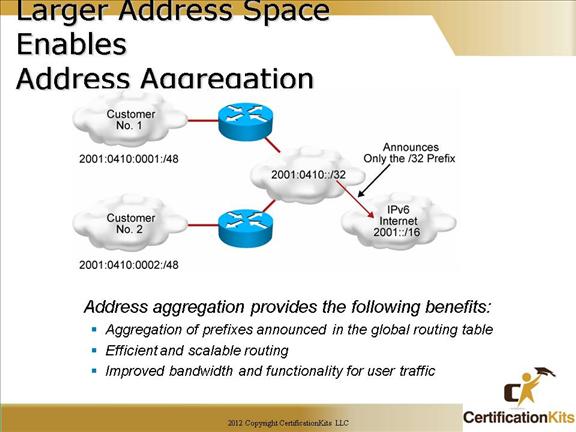Cisco CCNA Internet Protocol Version 6
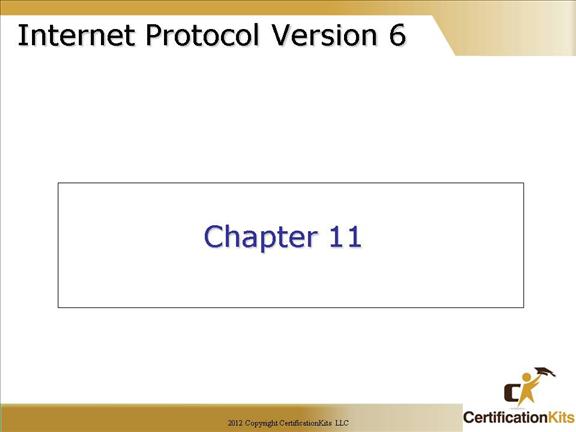
Now that you know about IPv4, it is time to learn about IPv6.
Cisco CCNA IPv4 and IPv6
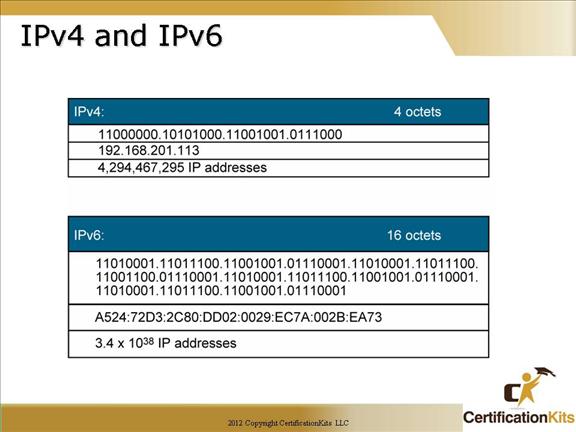
An IPv4 address is 32 bits (4 octets) whereas an IPv6 address is 128 bits (16 octets).
IPv4 addresses are typically represented in dotted decimal notation whereas IPv6 addresses are typically represented in HEX.
IPv4 supports just over 4 million addresses whereas IPv6 supports just over 4 billion addresses. Yes you read correctly, over 4 billion.
Cisco CCNA Why Do We Need a Larger Address Space?
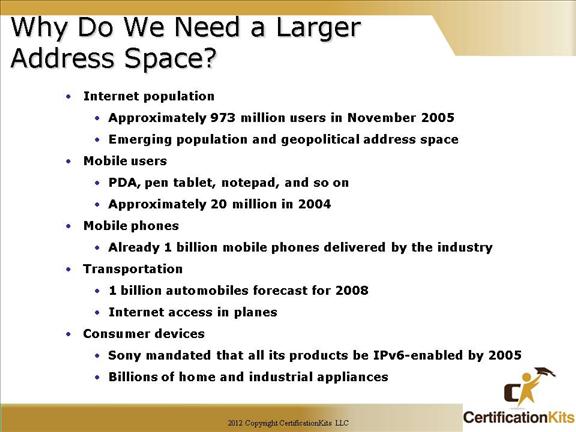
For years IPv4 address space has been slowly depleted. With the deployment of RFC 1918, Private Addresses, the depletion of IPv4 addresses has slowed significantly, but with explosion of IP capable devices along with their uses, it is only a matter of time before the entire IPv4 address space is depleted.
As stated on the previous slide, while IPv4 address space supports just over 4 million addresses, IPv6 address space supports over 4 billion addresses.
Cisco CCNA IPv6 Advanced Features
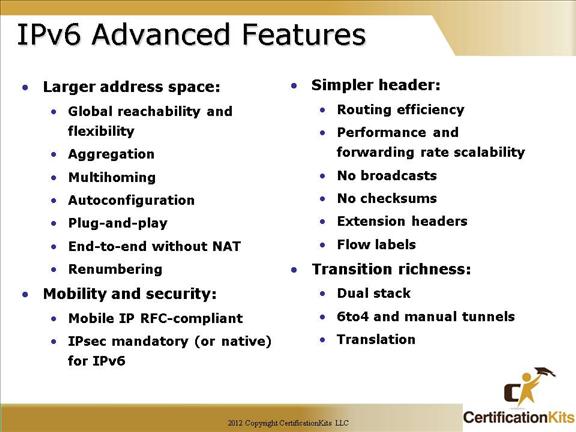
IPv6 has a vastly larger address space than IPv4. This results from the use of a 128-bit address, whereas IPv4 uses only 32 bits. The new address space thus supports 2128 (about 3.4×1038) addresses.
IPv6 also implements new features that simplify aspects of address assignment (stateless address autoconfiguration) and network renumbering (prefix and router announcements) when changing Internet connectivity providers. The IPv6 subnet size has been standardized by fixing the size of the host identifier portion of an address to 64 bits to facilitate an automatic mechanism for forming the host identifier from Link Layer media addressing information (MAC address).
Network security is integrated into the design of the IPv6 architecture. Internet Protocol Security (IPsec) was originally developed for IPv6, but found widespread optional deployment first in IPv4 (into which it was back-engineered). The IPv6 specifications mandate IPsec implementation as a fundamental interoperability requirement.
Multicast, the ability to send a single packet to multiple destinations, is part of the base specification in IPv6. This is unlike IPv4, where it is optional (although usually implemented). IPv6 does not implement broadcast, which is the ability to send a packet to all hosts on the attached link. The same effect can be achieved by sending a packet to the link-local all hosts multicast group. It therefore lacks the notion of a broadcast address—the highest address in a subnet (the broadcast address for that subnet in IPv4) is considered a normal address in IPv6.
Cisco CCNA IPv6 Address Representation
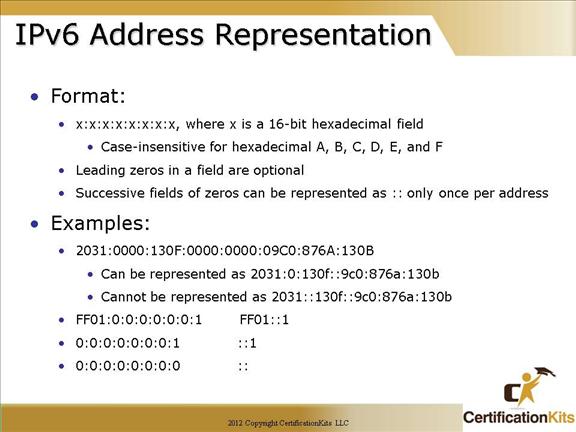
Unlike the familiar IPv4 addresses which are 32 bits long, written in decimal, and separated by periods, IPv6 addresses are 128 bits long, written in hexadecimal, and separated by colons. An example would be:
3ffe:1900:4545:3:200:f8ff:fe21:45cf
Colons separate 16-bit fields. Leading zeros can be omitted in each field as can be seen above where the field :0003: is written :3:. In addition, a double colon (::) can be used once in an address to replace multiple fields of zeros. For example:
fe80:0:0:0:200:f8ff:fe21:45cf
can be written as
fe80::200:f8ff:fe21:45cf
Cisco CCNA IPv6 Address Types
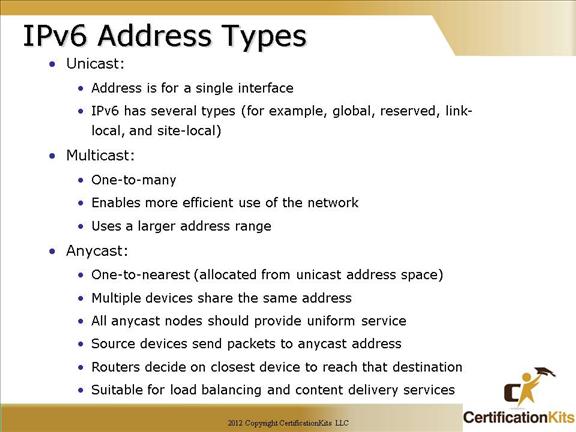
IPv6 addresses are classified into three types: unicast addresses which uniquely identify network interfaces, anycast addresses which identify a group of interfaces—mostly at different locations—for which traffic flows to the nearest one, and multicast addresses which are used to deliver one packet to many interfaces. Broadcast addresses are not used in IPv6. Each IPv6 address also has a ‘scope’, which specifies in which part of the network it is valid and unique. Some addresses have node scope or link scope; most addresses have global scope (i.e. they are unique globally).
Some IPv6 addresses are used for special purposes, like the loopback address. Also, some address ranges are considered special, like link-local addresses (for use in the local network only) and solicited-node multicast addresses (used in the Neighbor Discovery Protocol).
Cisco CCNA IPv6 Unicast Addressing
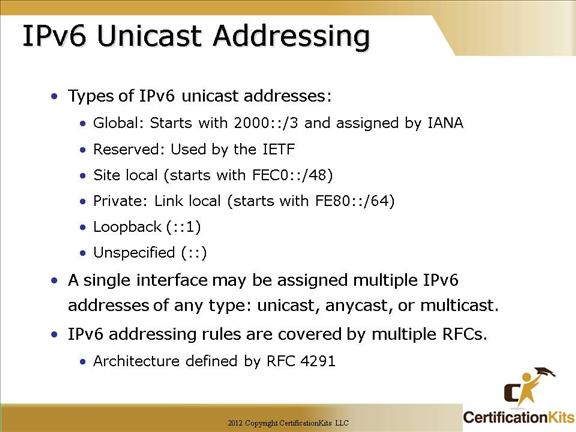
Unicast global addresses
IPv6 unicast global addresses are similar to IPv4 public addresses. Also known as aggregatable global unicast addresses, global addresses are globally routable. The structure of an IPv6 unicast global address creates the three-level topology.
Unicast site-local addresses
IPv6 unicast site-local addresses are similar to IPv4 private addresses. The scope of a site-local address is the internetwork of an organization’s site. (You can use both global addresses and site-local addresses in your network.) The prefix for site-local addresses is FEC0::/48.
Unicast link-local addresses (FE80::/64)
IPv6 unicast link-local addresses are similar to IPv4 APIPA addresses used by computers running Microsoft Windows. Hosts on the same link (the same subnet) use these automatically configured addresses to communicate with each other. Neighbor Discovery provides address resolution. The prefix for link-local addresses is FE80::/64.
Cisco CCNA IPv6 Global Unicast (and Anycast) Addresses
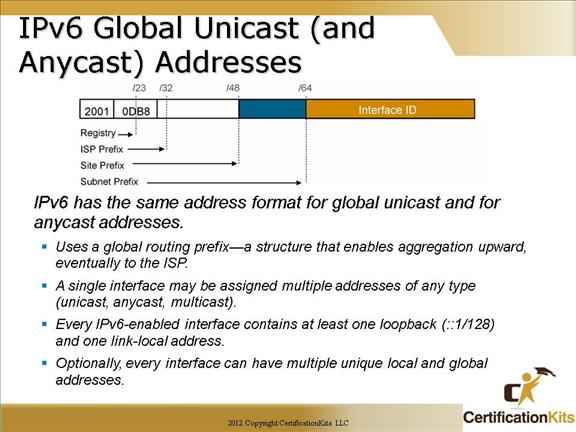
Cisco CCNA Link-Local Addresses
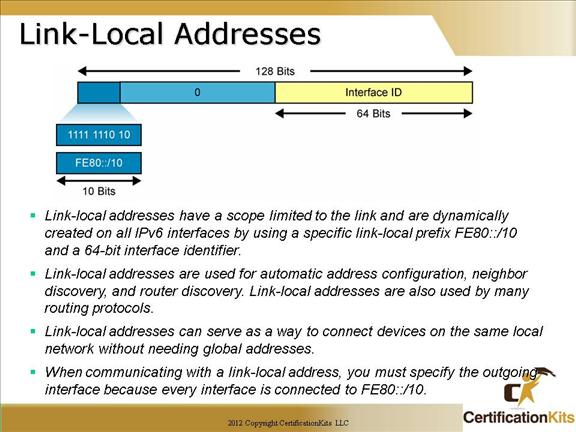
Cisco CCNA Larger Address Space Enables Address Aggregation
